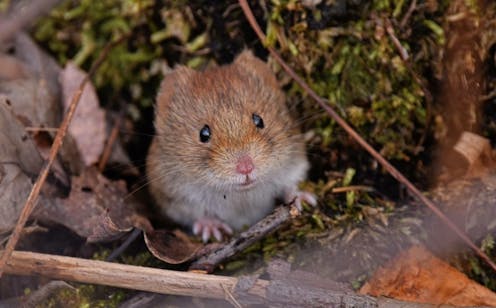What is Alaskapox? A microbiologist explains the recently discovered virus that just claimed its fir
Alaskapox was discovered in 2015 and has generally only caused mild illness – until now.

Alaskapox, a virus in the same family as smallpox, cowpox and mpox, claimed its first fatality in January 2024 when an elderly Alaskan man died of the illness.
The virus, which was discovered in 2015, had previously resulted in only relatively mild illnesses in the six other people infected by it. So why did the Alaskan man die?
Raúl Rivas González, a microbiologist at the University of Salamanca in Spain, explains what we know about Alaskapox, what happened to the man in Alaska, and the threat posed by the thousands of similar viruses out there.
What’s the origin of Alaskapox?
Alaskapox is an orthopox virus discovered in 2015 in the Fairbanks area of Alaska.
Until the most recent case, there were only six known human infections, which all involved mild illnesses consisting of a localized rash and the swelling of lymph nodes.
How did the man in Alaska die?
In mid-September 2023, the man was living on the Kenai Peninsula, south of the city of Anchorage, Alaska, and undergoing drug treatment for cancer, and so had a suppressed immune system. He noticed a tender red papule – a type of skin lesion – in his right armpit.
Understandably, he was scared and decided to go to the doctor immediately. Over the next six weeks, he made several visits to the primary care center and the local emergency department for clinical evaluation of the lesion.
The case was confusing and the possible infection difficult to identify. He did not respond to antibiotic treatment. A needle biopsy revealed no evidence of malignancy or bacterial infection. The health care providers were puzzled.
After the situation worsened, the man was hospitalized in Anchorage. Eventually, doctors performed an extensive battery of tests and sent a sample to the Centers for Disease Control and Prevention, which determined he had Alaskapox.
He was immediately given treatment for the virus, but it was too late and he died at the end of January. Officials confirmed the cause of death was Alaskapox in February.
Where do viruses like Alaskapox come from?
Currently, more than 10,000 species of viruses have been recognized by the International Committee on Taxonomy of Viruses. We know that about 270 of them can infect people.
Some of these viruses have been known for centuries, such as polio and smallpox, while others like Alaskapox have only recently emerged. In fact, viruses constitute about two-thirds of all new human pathogens. These new viruses differ widely in their risk to human health, ranging from the rare and mild illness caused by the Menangle virus to the devastating public health impact of the virus that causes COVID-19.
Of the viruses known to infect humans, about 80% are naturally occurring in nonhuman hosts, primarily in mammals and birds and, to a lesser extent, in arthropods and other wildlife.
Infectious agents transmitted from animals to humans are estimated to constitute about 60% of known human pathogens and up to 75% of emerging human pathogens. Unfortunately, there is insufficient knowledge about wild animals that may harbor thousands of unknown virus species that could be human pathogens.
The evidence so far indicates that the Alaskapox virus is present in several species of small mammals, most notably shrews and the red-backed vole. In other words, Alaskapox is a new example of an infectious disease that can make the leap from animals to humans, a process known as zoonosis. Although available data suggests that the public health impact of Alaskapox virus is limited, it is likely widespread in small mammal populations in Alaska, and other infections in people may not have been diagnosed.
At present, no person-to-person transmission of Alaskapox has been documented. However, because some types of orthopoxviruses can be transmitted by direct contact with skin lesions, it is recommended that people with wounds that are suspected to be caused by Alaskapox keep the affected area covered with a bandage.
What other orthopoxviruses pose a risk?
In addition to Alaskapox virus, some other orthopoxviruses have recently been recognized, such as Akhmeta virus and/or Abatino virus, that highlight the possibility of unknown members of this genus with zoonotic potential.
Other orthopoxviruses with zoonotic potential, such as mpox virus and cowpox virus, are increasingly being reported as a cause of human disease. In fact, the ongoing mpox outbreak that started in May 2022 has resulted in more than 93,000 cases and 177 deaths. This situation may have been facilitated by the discontinuation of routine vaccination against the eradicated human smallpox, as this vaccine gave rise to some degree of population immunity against other orthopoxviruses.
In addition to the above, there are many other orthopoxviruses that infect mammals. Examples are the ectromelia virus that causes mousepox, camelpox, raccoonpox, gerbilpox and skunkpox or some sublineages of vaccinia virus such as rabbitpox and buffalopox.
Poxviruses infect a broad spectrum of hosts, including insects, birds, reptiles and mammals. The wide host range, the wide geographical distribution and the constant global emergence of zoonotic viruses, including new orthopoxviruses, pose a global health threat that requires close monitoring and appropriate preventive measures.
In this situation, I believe the most prudent course of action is to urgently adopt a One Health approach that recognizes that the health of humans, animals, plants and the wider environment are interconnected, and accept that we cannot address human health without also addressing animal and environmental health.
Raúl Rivas González does not work for, consult, own shares in or receive funding from any company or organization that would benefit from this article, and has disclosed no relevant affiliations beyond their academic appointment.
Read These Next
Why do family companies even exist? They know how to ‘win without fighting’
My team analyzed decades of research on family businesses to find out their secret sauce. Three key…
Google plans to power a new data center with fossil fuels, yet release almost no emissions – here’s
To reduce emissions put into the atmosphere, Google is using carbon capture and sequestration. But not…
High-speed rail moves millions throughout the world every day – but in the US, high cost and low use
Although some high-speed rail has been built in the northeastern US, the rest of the country has almost…




